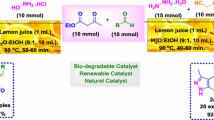Abstract
Although caffeic acid phenethyl ester (CAPE), an active flavonoid, plays an important role in the antioxidant activity of honeybee propolis, the isolation of CAPE from honeybee propolis is time-consuming due to wide variety of impurities present. Therefore, biochemical method to synthesize CAPE was investigated in this study. Since ionic liquids (ILs) possess some unique characteristics as appreciated alternatives to conventional solvents for certain biotransformation, the effect of ILs as reaction media for enzymatic synthesis of CAPE was assessed. Several factors including substrate molar ratio, and reaction temperature affecting the conversion yield of lipase-catalyzed CAPE synthesis were also investigated. Reaction yields were significantly higher in hydrophobic ILs than in hydrophilic ILs (almost zero). Among nine hydrophobic ILs tested, the highest conversion of synthetic reaction was obtained in 1-ethyl-3-methylimidazolium bis[(trifluoromethyl)sulfonyl]imide ([Emim][Tf2N]). A reaction temperature of 70 °C was found to give high conversion. In addition, optimal substrate molar ratio between phenethyl alcohol and caffeic acid (CA) was decreased significantly from 92:1 to 30:1 when ILs were used instead of isooctane.





Similar content being viewed by others
References
Russo A, Longo R, Vanella A (2002) Antioxidant activity of propolis: role of caffeic acid phenethyl ester and galangin. Fitoterapia 73(Suppl 1):S21–S29
Shahidi F, Wanasundara PK (1992) Phenolic antioxidants. Crit Rev Food Sci Nutr 32:67–103
Jung W-K, Lee D-Y, Kim J-H, Choi I, Park S-G, Seo S-K, Lee S-W, Lee C-M, Park Y-M, Jeon Y-J, Lee CH, Jeon B-T, Qian Z-J, Kim S-K, Choi I-W (2008) Anti-inflammatory activity of caffeic acid phenethyl ester (CAPE) extracted from Rhodiola sacra against lipopolysaccharide-induced inflammatory responses in mice. Process Biochem 43:783–787
Lee Y-J, Liao P-H, Chen W-K, Yang C–C (2000) Preferential cytotoxicity of caffeic acid phenethyl ester analogues on oral cancer cells. Cancer Lett 153:51–56
Chen JH, Shao Y, Huang MT, Chin CK, Ho CT (1996) Inhibitory effect of caffeic acid phenethyl ester on human leukemia HL-60 cells. Cancer Lett 108:211–214
Gao CA, Mayon P, MacManus DA, Vulfson EN (2000/2001) Novel enzymatic approach to the synthesis of flavonoid glycosides and their esters. Biotechnol Bioeng 71:235–243
Widjaja A, Yeh T-H, Ju Y-H (2008) Enzymatic synthesis of caffeic acid phenethyl ester. J Chin Inst Chem Eng 39:413–418
Yu Y-Y, Zhang W, Cao S-W (2007) Extraction of ferulic acid and caffeic acid with ionic liquids. Chin J Anal Chem 35:1726–1730
Moon YH, Lee SM, Ha SH, Koo Y-M (2006) Enzyme-catalyzed reactions in ionic liquids. Korean J Chem Eng 23:247–263
Parvulescu VI, Hardacre C (2007) Catalysis in ionic liquids. Chem Rev 107:2615–2665
Ha SH, Menchavez RN, Koo Y-M (2010) Reprocessing of spent nuclear waste using ionic liquids. Korean J Chem Eng 27:1360–1365
Swatloski RP, Spear SK, Holbrey JD, Rogers RD (2002) Dissolution of cellose with ionic liquids. J Am Chem Soc 124:4974–4975
Ha SH, Mai NL, An G, Koo Y-M (2011) Microwave-assisted pretreatment of cellulose in ionic liquid for accelerated enzymatic hydrolysis. Bioresour Technol 102:1214–1219
Zhao H (2006) Innovative applications of ionic liquids as green engineering liquids. Chem Eng Commun 193:1660–1677
Park S, Kazlauskas RJ (2001) Improved preparation and use of room-temperature ionic liquids in lipase-catalyzed enantio- and regioselective acylations. J Org Chem 66:8395–8401
Kim MJ, Choi MY, Lee JK, Ahn Y (2003) Enzymatic selective acylation of glycosides in ionic liquids: significantly enhanced reactivity and regioselectivity. J Mol Catal B: Enzym 26:115–118
Ha SH, Lee SH, Dang DT, Kwon MS, Chang W-J, Yu YJ, Byun IS, Koo Y-M (2008) Enhanced stability of Candida antarctica lipase B in ionic liquids. Korean J Chem Eng 25:291–294
Lee SH, Koo Y-M, Ha SH (2008) Influence of ionic liquids under controlled water activity and low halide content on lipase activity. Korean J Chem Eng 25:1456–1462
Kurata A, Kitamura Y, Irie S, Takemoto S, Akai Y, Hirota Y, Fujita T, Iwai K, Furusawa M, Kishimoto N (2010) Enzymatic synthesis of caffeic acid phenethyl ester analogues in ionic liquid. J Biotechnol 148:133–138
Lopes JNAC, Padua AAH (2006) Nanostructural organization in ionic liquids. J Phys Chem B 110:3330–3335
Belafi-Bako K, Dormo N, Ulbert O, Gubicza L (2002) Application of pervaporation for removal of water produced during enzymatic esterification in ionic liquids. Desalination 149:267–268
Husum TL, Jorgensen CT, Christensen MW, Kirk O (2001) Enzyme catalysed synthesis in ambient temperature ionic liquids. Biocatal Biotransform 19:331–338
Derecskei B, Derecskei-Kovacs A (2008) Molecular modelling simulations to predict density and solubility parameters of ionic liquids. Mol Sim 34:1167–1175
Sureshkumar M, Lee C-K (2009) Biocatalytic reactions in hydrophobic ionic liquids. J Mol Catal B: Enzym 60:1–12
Shimada Y, Watanabe Y, Sugihara A, Tominaga Y (2002) Enzymatic alcoholysis for biodiesel fuel production and application of the reaction to oil processing. J Mol Catal B: Enzym 17:133–142
Fernandez JF, Waterkamp D, Thoming J (2008) Recovery of ionic liquids from wastewater: aggregation control for intensified membrane filtration. Desalination 224:52–56
Binder JB, Raines RT (2010) Fermentable sugars by chemical hydrolysis of biomass. PNAS 107:4516–4521
Lee SH, Ha SH, You C-Y, Koo Y-M (2007) Recovery of magnetic ionic liquid [bmim]FeCl4 using electromagnet. Korean J Chem Eng 24:436–437
Ha SH, Mai NL, Koo Y-M (2010) Microwave-assisted separation of ionic liquids from aqueous solution of ionic liquids. J Chromatogr A 1217:7638–7641
Acknowledgments
This paper has been supported by 2011 Hannam University Research Fund.
Author information
Authors and Affiliations
Corresponding authors
Rights and permissions
About this article
Cite this article
Ha, S.H., Anh, T.V., Lee, S.H. et al. Effect of ionic liquids on enzymatic synthesis of caffeic acid phenethyl ester. Bioprocess Biosyst Eng 35, 235–240 (2012). https://doi.org/10.1007/s00449-011-0601-4
Received:
Accepted:
Published:
Issue Date:
DOI: https://doi.org/10.1007/s00449-011-0601-4




